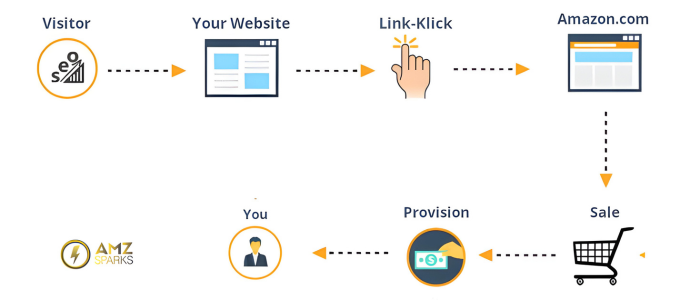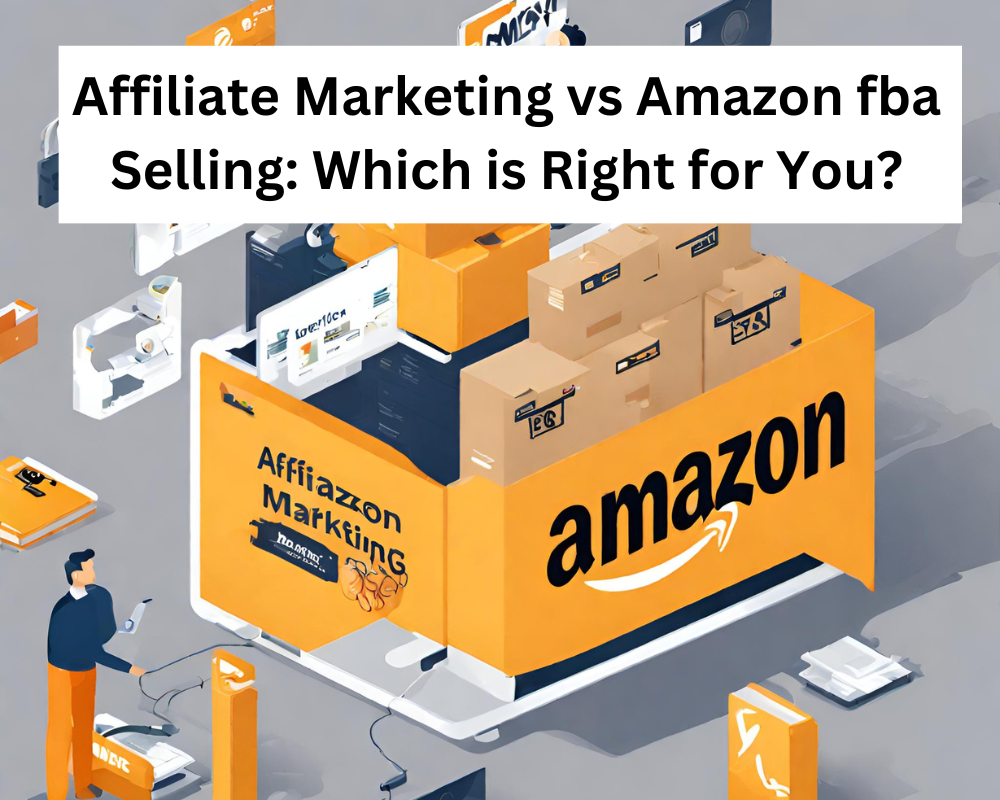Exploring the Pros and Cons of Affiliate Marketing vs Amazon fba Selling: Which is Right for You?
In the ever-expanding realm of online business, choosing the right strategy is paramount for success. Two popular models that often stand out are Amazon Affiliate Marketing and Amazon FBA Selling. Each comes with its own set of advantages and disadvantages, making the decision-making process complex for aspiring entrepreneurs. In this article, we will explore the pros and cons of both approaches to help you determine which is the right fit for your goals and aspirations.
Table of Contents
Affiliate Marketing vs Amazon FBA
affiliate marketing vs amazon fba play distinct yet crucial roles in the e-commerce landscape. Affiliate marketing serves as a powerful avenue for individuals and content creators to earn passive income by promoting products and earning commissions on sales. It requires minimal upfront investment and allows for flexibility in content creation. On the other hand, Amazon FBA empowers entrepreneurs to build and scale their own e-commerce brands by leveraging Amazon’s extensive infrastructure for product storage, shipping, and customer service. It provides an opportunity for direct product ownership, brand development, and higher profit margins. Amazon fba vs affiliate marketing, Together, these models contribute to the diversity and dynamism of the online marketplace, catering to a range of business preferences and objectives.
Understanding Amazon Affiliate Marketing
What is Amazon Affiliate Marketing?
Amazon Affiliate Marketing involves promoting products on the platform and earning a commission for each sale made through your unique affiliate link. It’s essentially a performance-based marketing strategy.
How does the affiliate program work?
Affiliates create content, such as blog posts or videos, where they showcase and recommend Amazon products. When a user clicks on their affiliate link and makes a purchase, the affiliate earns a percentage of the sale.
Advantages of Amazon Affiliate Marketing
One of the key benefits is the potential for passive income. Affiliates don’t need to handle inventory, manage customer service, or worry about shipping. This makes it an attractive option for those looking for a low-maintenance side hustle.

Also Read: How to Make Money with Amazon Affiliate Marketing
Delving into Amazon FBA Selling
Amazon FBA involves sourcing products, sending them to Amazon’s fulfillment centers, and letting the platform handle storage, packing, and shipping. This model is ideal for those who want to sell physical products without dealing with the logistics.
How FBA differs from traditional selling on Amazon
Unlike traditional sellers, FBA sellers leverage Amazon’s infrastructure for storage and shipping. This means they benefit from Prime eligibility and Amazon’s customer trust.
Pros and cons of Amazon FBA Selling
Pros:
- Prime eligibility and shipping benefits: FBA sellers can offer Prime shipping, providing a competitive edge.
- Access to Amazon’s vast customer base: Leveraging Amazon’s customer base can result in higher sales.
- Scalability and potential for high-profit margins: FBA allows sellers to scale their business without worrying about fulfillment logistics.
Cons:
- Upfront costs and fees: There are initial costs and ongoing fees associated with using FBA.
- Dependency on Amazon’s fulfillment process: Sellers relinquish control over packing and shipping.
- Competition and market saturation: The popularity of FBA has led to increased competition and market saturation.
Also Read: 10 Proven Marketing Strategy of Amazon to Boost Your Sales
Pros of Amazon Affiliate Marketing
Passive income potential
One of the most attractive features of affiliate marketing is the ability to earn passive income. Once you’ve created content and shared your affiliate links, you can continue to earn commissions without actively managing the sales process.
Low upfront costs
Affiliate marketing typically requires minimal upfront investment. You don’t need to buy inventory or deal with the complexities of product sourcing, making it a cost-effective option for beginners.
No need for inventory management
Unlike FBA selling, affiliate marketers don’t handle inventory. This means no storage costs, no worries about product expiration, and no headaches related to managing stock levels.
Cons of Amazon Affiliate Marketing
Limited control over product promotion
Affiliate marketers rely on their ability to create compelling content and drive traffic to their affiliate links. However, they have limited control over how the product is presented on Amazon, potentially affecting conversion rates.
Earnings depend on Amazon’s policies
Affiliate commissions are subject to Amazon’s policies, and changes in the affiliate program can impact earnings. This lack of control over the revenue stream can be a concern for some marketers.
Potential for affiliate link misuse
Unscrupulous individuals may misuse affiliate links, leading to lost commissions for the legitimate affiliate. Monitoring and preventing this misuse can be challenging.
Pros of Amazon FBA Selling
Prime eligibility and shipping benefits
FBA sellers can offer Prime shipping, a significant advantage in the eyes of Amazon customers. This can lead to higher conversion rates and increased sales.
Access to Amazon’s vast customer base
Selling through FBA means tapping into Amazon’s extensive customer base. This built-in audience can be a game-changer for sellers looking to expand their reach.
Scalability and potential for high-profit margins
FBA allows sellers to scale their operations without worrying about fulfillment logistics. This scalability, coupled with the potential for high-profit margins, makes it an enticing option for ambitious entrepreneurs.
Also read: What is Affiliate Marketing for Amazon
Cons of Amazon FBA Selling
Upfront costs and fees
Launching an FBA business involves upfront costs such as product sourcing, shipping to Amazon, and
Amazon’s fees. This financial commitment can be a barrier for some individuals.
Dependency on Amazon’s fulfillment process
While FBA streamlines the fulfillment process, sellers relinquish control over packing and shipping. Any issues or delays in Amazon’s fulfillment centers can impact customer satisfaction.
Competition and market saturation
The popularity of FBA has led to increased competition, making it challenging for new sellers to stand out. Niche selection and effective marketing become crucial to success.
Factors to Consider When Choosing
Type of products you want to sell
The nature of your products plays a significant role in determining the most suitable model. Physical products may align better with FBA, while digital or informational products might be more conducive to affiliate marketing.
Your budget and financial goals
Consider your budgetary constraints and financial objectives. Affiliate marketing often requires less initial investment, making it accessible to those with limited funds. FBA, on the other hand, demands a more substantial upfront financial commitment.
Time and effort required for each model
Evaluate the time and effort you’re willing to invest. Affiliate marketing can be a part-time endeavor, while FBA selling may demand more hands-on involvement, especially during the initial setup phase.
Step-by-step guide for becoming an Amazon Affiliate
- Sign up for the Amazon Affiliate Program: Visit the Amazon Associates website and complete the registration process.
- Create quality content: Develop a blog, YouTube channel, or other platforms to showcase products.
- Insert affiliate links strategically: Integrate affiliate links naturally within your content.
- Drive traffic: Employ SEO strategies and social media promotion to attract visitors.
- Optimize for conversions: Experiment with different content types and analyze what resonates with your audience.
Setting up an Amazon FBA account
- Create an Amazon Seller Account: Navigate to the Amazon Seller Central website and set up your account.
- Choose a product niche: Research and select a niche that aligns with market demand.
- Source products: Find reliable suppliers or manufacturers for your chosen products.
- Ship products to Amazon: Send your inventory to Amazon’s fulfillment center.
- Optimize product listings: Craft compelling product descriptions and use high-quality images.
- Promote your products: Implement marketing strategies to increase visibility and sales.
Also Read: Guide to Advertising on Amazon: Advanced Marketing Strategies for E-Commerce Sellers
Tips for Success
Strategies for maximizing affiliate earnings
- Choose products wisely: Select products relevant to your niche and audience.
- Create engaging content: Develop content that educates, entertains, and encourages action.
- Build a loyal audience: Foster relationships with your audience for sustained success.
Best practices for successful Amazon FBA selling
- Research market trends: Stay informed about market demands and adjust your product selection accordingly.
- Optimize product listings: Use relevant keywords and high-quality images to enhance visibility.
- Provide excellent customer service: Positive reviews and customer satisfaction contribute to long-term success.
The Future of Amazon Business Models
Predictions and trends for affiliate marketing and FBA
- Rise of influencer marketing: Affiliate marketing may see a surge in influencer collaborations.
- Increased automation in FBA: Advancements in technology may streamline FBA processes.
Evolving opportunities and challenges
- Growing international markets: Both models may witness increased opportunities in global markets.
- Stricter regulations: Compliance challenges may arise, impacting both affiliate marketing and FBA.
Conclusion
In the dynamic landscape of online business, the choice between Amazon affiliate marketing, Amazon FBA Selling, and hiring an Amazon Marketing Agency is not a one-size-fits-all decision. Understanding the pros and cons of each model, considering personal preferences, and aligning with your goals are crucial steps in making the right choice. Whether you prefer the passive income potential of affiliate marketing or the scalability of FBA selling, both avenues, along with the expertise provided by an Amazon Marketing Agency, offer opportunities for success in the ever-expanding Amazon marketplace.
FAQs
Can I do both Amazon Affiliate Marketing and FBA selling simultaneously?
Yes, some entrepreneurs successfully combine both models to diversify their income streams.
Are there any restrictions on the types of products I can promote as an Amazon Affiliate?
While there are guidelines, Amazon’s product selection is vast, allowing for promotion in various niches.
How long does it take to see results with Amazon Affiliate Marketing?
Results vary, but consistent effort and strategic content creation can yield results within a few months.
What’s the biggest challenge for new FBA sellers?
Initial challenges often include product selection, understanding Amazon’s algorithms, and managing upfront costs.
Is it possible to switch from Amazon Affiliate Marketing to FBA selling (or vice versa) later on?
Yes, many entrepreneurs transition between the two models based on their evolving business strategies.

